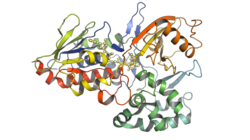| 15-cis-phytoene desaturase | |||||||||
|---|---|---|---|---|---|---|---|---|---|
 | |||||||||
| Identifiers | |||||||||
| EC no. | 1.3.5.5 | ||||||||
| Databases | |||||||||
| IntEnz | IntEnz view | ||||||||
| BRENDA | BRENDA entry | ||||||||
| ExPASy | NiceZyme view | ||||||||
| KEGG | KEGG entry | ||||||||
| MetaCyc | metabolic pathway | ||||||||
| PRIAM | profile | ||||||||
| PDB structures | RCSB PDB PDBe PDBsum | ||||||||
| Gene Ontology | AmiGO / QuickGO | ||||||||
| |||||||||
15-cis-phytoene desaturases (PDS, plant-type phytoene desaturases) (EC 1.3.5.5, 15-cis-phytoene:plastoquinone oxidoreductase), are enzymes involved in the carotenoid biosynthesis in plants and cyanobacteria. [2] Phytoene desaturases are membrane-bound enzymes localized in plastids and introduce two double bonds into their colorless substrate phytoene by dehydrogenation and isomerize two additional double bonds. [3] [4] This reaction starts a biochemical pathway involving three further enzymes (zeta-carotene isomerase, zeta-carotene desaturase and carotene cis-trans isomerase) called the poly-cis pathway and leads to the red colored lycopene. The homologous phytoene desaturase found in bacteria and fungi (CrtI) converts phytoene directly to lycopene by an all-trans pathway. [5]
